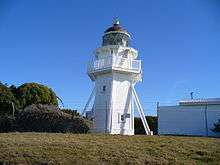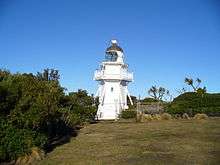Katiki Point Lighthouse
 Katiki Point Lighthouse | |
 New Zealand | |
| Location |
Katiki Point South Island New Zealand |
|---|---|
| Coordinates | 45°23′30.7″S 170°51′58.2″E / 45.391861°S 170.866167°ECoordinates: 45°23′30.7″S 170°51′58.2″E / 45.391861°S 170.866167°E |
| Year first constructed | 1878 |
| Year first lit | 1878 |
| Construction | wooden tower |
| Tower shape | hexagonal prism tower with balcony and lantern |
| Markings / pattern | white tower, red trim, black lantern |
| Height | 8 metres (26 ft) |
| Focal height | 58 metres (190 ft). |
| Current lens | light-emitting diode |
| Light source | mains power |
| Range | 10 nautical miles (19 km; 12 mi) |
| Characteristic | Fl W 12s. |
| Admiralty number | K4360 |
| NGA number | 5368 |
| ARLHS number | NZL-034[1] |
| Managing agent | Maritime New Zealand |
The Katiki Point Lighthouse, also known as Moeraki Lighthouse, shone for the first time in 1878, following several accidents on the dangerous reefs around the area, to make the area safer for ships that sailed past on their way to Port Chalmers, Dunedin.[2][3][4] The lighthouse was built between the settlements of Moeraki and Katiki, on the tip of the Moeraki Peninsula, which is known as Katiki Point or Moeraki Point.
History
The point has a long history of wrecks, notably the wrecking of the ancestral waka atua on a return trip from Hawaiki, leaving some of the cargo being on the beach at Katiki, below the lighthouse.[5][6] Tradition holds that the remains of the cargo are the Moeraki Boulders. Just before the light was to be lit for the first time, a storm shook the tower to the extent that the lamp glass broke. A new one had to be ordered, and the tower was strengthened, before the light was lit on 22 April 1878.[7]

The wooden tower stands 26 feet (8 m) high and 190 feet (58 m) above sea level. The light flashes on for 6 seconds and off for 6 seconds, and can be seen for 10 nautical miles (20 km). The light-emitting diode beacon is supplied by mains electricity, with a battery for standby power. The original lens operated with a 1000-watt lamp supplied by mains electricity, with a diesel generator for standby power. It can still be seen in the lantern room at the top of the tower.
The light was fully automated in 1975 and the lighthouse keeper was withdrawn. The operation of the light is now fully automatic and is monitored by a computer and Maritime New Zealand staff in Wellington. The lighthouse was restored by Maritime New Zealand in 2006.[8]
See also
References
- ↑ Rowlett, Russ. "Lighthouses of New Zealand: South Island". The Lighthouse Directory. University of North Carolina at Chapel Hill. Retrieved February 23, 2016.
- ↑ Maritime New Zealand
- ↑ New Zealand Lighthouses - Moeraki (Katiki Point)
- ↑ Maritime New Zealand - Lighthouse locations
- ↑ Department of Conservation - Field trip guide
- ↑ Ngai Tahu Claims Settlement Act 1998 - Statutory acknowledgement for Te Tai o Arai Te Uru (Otago Coastal Marine Area)
- ↑ "Katiki Point Lighthouse". Maritime New Zealand. Retrieved 24 February 2016.
- ↑ Maritime New Zealand - Restoration
- McLean, G. (1986) Moeraki Dunedin, NZ: Otago Heritage Books. ISBN 0-9597723-3-2.
External links
- Lighthouses of New Zealand Maritime New Zealand
| Wikimedia Commons has media related to Katiki Lighthouse. |